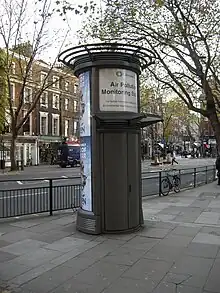London Air Quality Network
The London Air Quality Network (LAQN) is a collection of urban air pollution monitoring stations in London and South East England. Launched in 1993 by researchers at King's College, London,[1] it is currently managed by the Environmental Research Group of Imperial College with funding from local authorities, business improvement districts, Transport for London, and Defra, and has grown to become "the largest air-quality measuring system of its kind in the world".[2]

Each monitoring station consists of automated sensing equipment in a fixed cabin, typically positioned by a roadside or other busy urban area, which takes various pollution samples roughly every 15 minutes, so allowing both short- and long-term analysis of air quality.[3]
The data produced by the network has been used to inform scientific and medical research, public policy, and public understanding of air pollution issues for over three decades.[4][5] It's also used to generate near-real-time air-quality measurements, pollution maps, statistics, and alerts through a dedicated website (londonair.org.uk), phone app ("London Air"), and Twitter feed (@londonair), as well as bus and tube station "countdown" signs.[6]
References
- "About LondonAir". London Air. Imperial College, London.
- Fishwick, Samuel (15 November 2018). "The deadly killer we can't see and refuse to confront". Evening Standard. Retrieved 27 November 2021.
- "How is pollution measured?". London Air. Imperial College, London. Retrieved 27 November 2021.
- Burford, Rachel (22 April 2021). "Earth Day: Pandemic lockdown brings down air pollution by up to 70% in some London areas". Evening Standard. Retrieved 27 November 2021.
- "About Breathe London Network". Imperial College, London. Retrieved 27 November 2021.
- Date, Will (30 January 2018). "London's air quality alerts system to be improved". Air Quality News. Retrieved 27 November 2021.